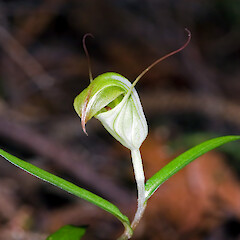Pterostylis brumalis
Common name
kauri greenhood, winter greenhood
Synonyms
Diplodium brumale (L.B.Moore) D.L.Jones, Molloy et M.A.Clem.
Family
Orchidaceae
Flora category
Vascular – Native
Endemic taxon
Yes
Endemic genus
No
Endemic family
No
Structural class
Orchids
NVS code
The National Vegetation Survey (NVS) Databank is a physical archive and electronic databank containing records of over 94,000 vegetation survey plots - including data from over 19,000 permanent plots. NVS maintains a standard set of species code abbreviations that correspond to standard scientific plant names from the Ngä Tipu o Aotearoa - New Zealand Plants database.
DIPBRU
Chromosome number
2n = 50
Current conservation status
The conservation status of all known New Zealand vascular plant taxa at the rank of species and below were reassessed in 2017 using the New Zealand Threat Classification System (NZTCS) – more information about this can be found on the NZTCS website. This report includes a statistical summary and brief notes on changes since 2012 and replaces all previous NZTCS lists for vascular plants.
Please note, threat classifications are often suggested by authors when publications fall between NZTCS assessment periods – an interim threat classification status has not been assessed by the NZTCS panel.
- Conservation status of New Zealand indigenous vascular plants, 2017 . 2018. Peter J. de Lange, Jeremy R. Rolfe, John W. Barkla, Shannel P. Courtney, Paul D. Champion, Leon R. Perrie, Sarah M. Beadel, Kerry A. Ford, Ilse Breitwieser, Ines Schönberger, Rowan Hindmarsh-Walls, Peter B. Heenan and Kate Ladley. Department of Conservation. Source: NZTCS and licensed by DOC for reuse under the Creative Commons Attribution 4.0 International licence.
2017 | Not Threatened
Previous conservation statuses
2012 | Not Threatened
2009 | Not Threatened
2004 | Not Threatened
Distribution
Endemic. New Zealand: North Island (Te Paki to Kawhia Harbour and the northern Kaimai Ranges; most common north of Thames and Auckland City).
Habitat
Coastal to lower montane. Virtually confined to forests dominated by kauri (Agathis australis (D.Don). Lindl.) where it prefers shaded sites, and usually grows in kauri leaf litter and leaf mould, often directly beneath the trunks of this species. It may also grow in gumland scrub but usually then only in association with rotting kauri stumps or subfossil kauri leaf and gum deposits.
Detailed description
Terrestrial, colony forming, perennial herb. Plants at flowering up to 200 mm tall. Stem bright green often tinged with red, slender, terete, smooth; internodes usually < leaves. Petiolate leaves in separate loose rosettes or at the base the lower part of flowering stem; petiole distinct, up to 10 mm long; leaf lamina 5–12 × 5–12 mm, bright green or green, ovate-orbicular, apex subacute, upper leaf surface smooth. Cauline leaves 2–6, usually closely spaced and aggregated toward top of stem, subsessile to sessile, the lower pair transitional in shape between rosette and mid to upper cauline leaves, 15–40 × 2–8 mm, bright green to green, linear-lanceolate or narrow-elliptic, uppermost leaves usually overtopping ovary but usually falling short of the galea. Flower 1–(2) erect, most white with narrow dark green stripes. Dorsal sepal 15–30 mm tall, apex acuminate, usually down-curved. Lateral sepals diverging at a wide angle to form a U or a wide W shape when viewed from the front, the sinus distinctly jugate in side view, tips long-caudate and much overtopping galea. Petals almost as long as dorsal sepal, with a broad, more or less horizontal marginal strip exposed. Labellum narrow-triangular, arched and protruding, apex subacute. Column shorter than labellum; stigma elliptic, slightly prominent.
Manaaki Whenua Online Interactive Key
Similar taxa
Very distinctive and not easily confused with other Pterostylis species. The flower has a very strongly incurved dorsal sepal with the petals held horizontally thus imparting a distinctive cobra-hooded appearance. The prominent jug-shaped sinus of the lateral sepals is shared with P. alveata Garnet and P. trullifolia Hook.f. but is absent from P. alobula (Hatch) L.B.Moore. From all these species P. brumalis is separated by the linear-lanceolate or narrow-elliptic mid to upper stem leaves which tend to be aggregated towatd the stem apex. Ecologically P. brumalis is restricted to kauri forest.
Flowering
June–October
Flower colours
Green, White
Fruiting
July–November
Life cycle
Minute seeds are wind dispersed (Thorsen et al., 2009).
Propagation technique
Difficult—should not be removed from the wild
Etymology
pterostylis: Winged column
Where To Buy
Not commercially available
TAXONOMIC NOTES
Jane et al. (2010) following a thorough rDNA (ITS) based analysis of the segregate genera erected for Pterostylis R.Br. by Szlachekto (2001) and Jones et al. (2002) found no support to continue their recognition. This view is followed here.
Attribution
Description adapted from Moore and Edgar (1970)
References and further reading
Janes JK, Duretto MF. 2010. A new classification for subtribe Pterostylidinae (Orchidaceae), reaffirming Pterostylis in the broad sense. Australian Systematic Botany 23: 260–269. https://doi.org/10.1071/SB09052.
Jones DL, Clements MA, Molloy BPJ. 2002. A Synopsis of the Subtribe Pterostylidinae. Australian Orchid Research 4: 129–146.
Moore LB, Edgar E. 1970. Flora of New Zealand, Volume II. Indigenous Tracheophyta: Monocotyledones except Gramineae. Government Printer, Wellington, NZ. 354 p.
Szlachekto, D.L. 2001: Genera et Species Orchidalium 1. Polish Botanical Journal 46(1): 11–26.
Thorsen MJ, Dickinson KJM, Seddon PJ. 2009. Seed dispersal systems in the New Zealand flora. Perspectives in Plant Ecology, Evolution and Systematics 11: 285–309. https://doi.org/10.1016/j.ppees.2009.06.001.







